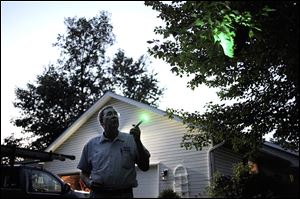
COMMENTARY: The sting of region’s harsh winter still being felt
8/19/2014
Russell Lamp, an Oregon-based pest control specialist, says we’ll see a lot more hornets and yellow jackets this fall.
Plan on a few additional guests for that Labor Day cookout, or for those first few tailgate parties of the college football season. They will be small, and nasty, and universally unwelcome.
The buzzing, stinging insects already are here in significant numbers, and more are coming. According to area entomologist Russell Lamp, there are five times as many hornet nests this year as we had last year, and yellow jackets are much more numerous, too.
“There are more hornets than we know what to do with right now, and these yellow jackets will be an issue for the rest of the summer, and especially on Labor Day weekend outings,” Lamp said. “They are after carbohydrates, so they will be wherever the food is.”
Hornets and yellow jackets are wasps. Lamp said their numbers are way up this year, primarily because of meteorological phenomena. The Polar Vortex, which has taken more blame since the dog that ate your homework, is one of the culprits again.
“The most limiting factor on these populations is the elimination of the queens during the springtime nesting period,” Lamp said. “The severe winter we had kept them in a hibernation state longer, and all of that snow we had piling up actually was kind of protecting them. Many of the queens survived.”
The past spring also did not have the dramatic temperature swings that we have experienced in recent years, and that helped keep the queens dormant longer. If the temperatures yo-yo, the queens can become active in an early warm spell, and then not survive a cold snap.
“In other years, we get a warm stretch and they come out and start nesting, and then we get another cold spell and they die,” he said.
Lamp said some insects were hit hard by the harsh winter but, in general, the stinging insects did quite well. And their numbers are increasing
From that single surviving queen in the spring, a nest can grow to hold 5,000 to 15,000 individual yellow jackets by fall.
Lamp, an Oregon-based pest control specialist, normally collects the large, paper lantern-like nests of bald-faced hornets that frequently hang from the branches of trees.
He cleans the nests and sorts the hornets, sending them to pharmaceutical companies in Pennsylvania, North Carolina, and Washington state. The hornets become part of a process that makes critical life-saving vaccine to protect people with severe allergic reactions to stings.
Lamp has already filled his quota for bald-faced hornet nests. Next month, Lamp will be collecting the nests of in-ground yellow jackets and sending those insects to the labs for vaccine production.
About 3 percent of the U.S. population has a severe allergy to bee, wasp, and hornet stings, a reaction that can range from hives to a rapid pulse, difficulty breathing, or shock and cardiac arrest. Bee stings kill more people in this country each year than snake bites, according to a study by Penn State University.
Lamp said there are 10 species of yellow jackets in Ohio, and this in-ground nesting variety — Vespula maculifrons — is one of the most aggressive.
“Fifty percent of the ground nests you find will be this type of yellow jacket, and they are very nasty,” Lamp said. “They are some of the smaller ones, but it’s the little ones that have the nastiest stings. It is a small yellow jacket, but very deadly to some people — the deadliest yellow jacket in Ohio.”
Lamp said he prefers to take the in-ground yellow jacket nests from sandy soils, since the nests are better preserved. In-ground nests found in clay soils present more challenges in the extraction process.
The in-ground yellow jackets will also nest in areas covered in mulch, or take over a burrow used by rodents.
Yellow jackets and bald-faced hornets are two of the more common of the hundreds of species of wasps. Most species of wasps build nests, not hives. Wasps do not produce honey, like bees do.
Lamp said he removes nests at night, since at most times during the day 40 percent of the inhabitants of the nest will be out flying around.
“I don’t like them coming at me from behind,” he said.
To reach Lamp for the removal of in-ground yellow jacket nests in September, call 419-836-3710.
Contact Blade outdoors editor Matt Markey at: mmarkey@theblade.com or 419-724-6068.